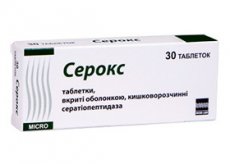Medical expert of the article
New publications
Preparations
Serox
Last reviewed: 04.07.2025

All iLive content is medically reviewed or fact checked to ensure as much factual accuracy as possible.
We have strict sourcing guidelines and only link to reputable media sites, academic research institutions and, whenever possible, medically peer reviewed studies. Note that the numbers in parentheses ([1], [2], etc.) are clickable links to these studies.
If you feel that any of our content is inaccurate, out-of-date, or otherwise questionable, please select it and press Ctrl + Enter.

Serox is a medicine that is prescribed for the treatment of diseases affecting the musculoskeletal system.
The component seratiopeptidase acts as a proteolytic enzyme, which is derived from a non-pathogenic intestinal microbe - Serratia type E15. The substance has anti-inflammatory, fibrinolytic, and anti-edematous activity. Along with reducing inflammation, the drug reduces the intensity of pain - by blocking the processes of releasing pain amines that occur inside the inflamed tissues.
Indications Seroxa
It is used in various areas of therapy:
- respiratory ducts and ENT system – facilitating the process of removing viscous bronchial sputum and secretions from the paranasal sinuses;
- surgery – for ligament ruptures and sprains, dislocations with fractures, inflammations and swellings, as well as in the case of damage to various soft tissues and after plastic surgery procedures;
- dermatology – acute inflammatory dermatoses;
- Gynecology: congestion in the mammary glands and hematomas.
Release form
The therapeutic element is released in tablets - 10 pieces in a strip; in a pack - 1 or 3 such strips.
Pharmacodynamics
Seratiopeptidase is synthesized with blood α-2-macroglobulin in a 1:1 ratio; the latter masks the antigenicity of the component, while maintaining its enzymatic activity. Later, it gradually moves into the exudate in the inflammation zone, and its blood indices decrease accordingly.
Due to the hydrolysis of histamine with bradykinin and serotonin, the substance seratiopeptidase directly weakens the dilation of capillaries, and at the same time controls the degree of their permeability. The element seratiopeptidase causes the blocking of substances that slow down the activity of plasmin, thereby leading to the development of its fibrinolytic effect. Weakening of edema and improvement of microcirculation processes help the processes of sputum discharge.
The enzymatic activity of the drug is ten times higher than similar indicators of α-chymotrypsin. The drug is extremely effective in hydrolyzing inflammatory conductors of polypeptide genesis (bradykinin, etc.) and fibrin, but does not have a significant effect on proteins of a living organism - among them albumin, as well as α- and γ-globulin. Serox does not lead to the breakdown of fibrinogen, so it does not have a significant effect on blood clotting.
The medicine penetrates well into inflamed areas, lyses tissues affected by necrosis with their metabolic elements, and also reduces hyperemia and increases the activity and rate of penetration of antibiotics. The medicine reduces the viscosity of saliva and nasal secretions, which facilitates their removal.
Pharmacokinetics
Serox penetrates the stomach unchanged, after which it is absorbed through the intestine. Plasma Cmax values are noted after 60 minutes. A small amount of seratiopeptidase is recorded in the urine.
Dosing and administration
Serox is required to be taken in a dosage of 1 tablet (10 mg) 3 times a day, after meals. The medicine is swallowed without chewing and washed down with plain water (1 glass). A maximum of 30 mg is allowed per day.
The duration of the therapy is selected individually, taking into account the progression of the disease process.
Use Seroxa during pregnancy
There are no data regarding the use of Serox in breastfeeding or pregnant patients.
Contraindications
Main contraindications:
- severe intolerance associated with seratiopeptidase or other components of the drug;
- severe disorders of the circulatory system.
Side effects Seroxa
Side effects include:
- lesions affecting the gastrointestinal tract: nausea, discomfort in the epigastric region, diarrhea, anorexia or vomiting;
- disorders of the respiratory system: occasional nosebleeds, eosinophilic pneumonia in the acute stage and the release of bloody sputum;
- People with intolerance may experience allergy symptoms: itching, rash and skin hyperemia.
Overdose
In case of poisoning, the following symptoms appear: anorexia, vomiting with nausea and discomfort affecting the gastrointestinal tract. In extreme situations, bleeding and blood in the secreted sputum were noted.
Symptomatic measures are carried out.
 [ 7 ]
[ 7 ]
Interactions with other drugs
The use of Serox together with anticoagulants leads to an increase in the therapeutic effect of the latter (such a combination should be used under the supervision of a doctor).
The drug accelerates the process of penetration of NSAIDs and antibiotics into inflamed tissues.
 [ 8 ]
[ 8 ]
Storage conditions
Serox must be stored in a place closed to small children. Temperature values - no more than 25°C.
Shelf life
Serox can be used for a period of 3 years from the date of manufacture of the drug.
Application for children
There is no information regarding the safety and medicinal efficacy of the drug in pediatrics, which is why it is not prescribed to this group of patients.
Analogues
Analogues of the drug are Wobenzym, Serta with Phlogenzym, as well as Serrata and Fibrinase.
Reviews
Serox receives good reviews from patients - it is effective against swelling, sprains and inflammations that occur in case of damage to soft tissues. It is considered a universal remedy. Another positive aspect is the low cost of the drug.
Attention!
To simplify the perception of information, this instruction for use of the drug "Serox" translated and presented in a special form on the basis of the official instructions for medical use of the drug. Before use read the annotation that came directly to medicines.
Description provided for informational purposes and is not a guide to self-healing. The need for this drug, the purpose of the treatment regimen, methods and dose of the drug is determined solely by the attending physician. Self-medication is dangerous for your health.

